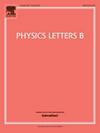根据最新的ACT观测,分数吸引子
IF 4.5
2区 物理与天体物理
Q1 ASTRONOMY & ASTROPHYSICS
引用次数: 0
摘要
根据ACT观测的最新结果,我们回顾了一类标记为分数吸引子的势,它们可以起源于帕拉蒂尼引力。我们表明,对于标量势V(ϕ)的某些选择,分数吸引子预测谱指数ns和张量-标量比r落在组合ACT+Planck数据的1σ区域内,适用于广泛的参数范围。在简单的二次和四次分数势的情况下,我们还提供了这些模型的参数空间的数值拟合。本文章由计算机程序翻译,如有差异,请以英文原文为准。
Fractional attractors in light of the latest ACT observations
In light of the latest results from ACT observations we review a class of potentials labeled as fractional attractors, that can originate from Palatini gravity. We show that, for certain choices of the scalar potential , the fractional attractors predict both a spectral index and a tensor-to-scalar ratio r that fall within the 1σ region of the combined ACT+Planck data for a wide range of parameters. We also provide a numerical fit for the parameter space of these models in the case of a simple quadratic and quartic fractional potential.
求助全文
通过发布文献求助,成功后即可免费获取论文全文。
去求助
来源期刊

Physics Letters B
物理-物理:综合
CiteScore
9.10
自引率
6.80%
发文量
647
审稿时长
3 months
期刊介绍:
Physics Letters B ensures the rapid publication of important new results in particle physics, nuclear physics and cosmology. Specialized editors are responsible for contributions in experimental nuclear physics, theoretical nuclear physics, experimental high-energy physics, theoretical high-energy physics, and astrophysics.
 求助内容:
求助内容: 应助结果提醒方式:
应助结果提醒方式:


